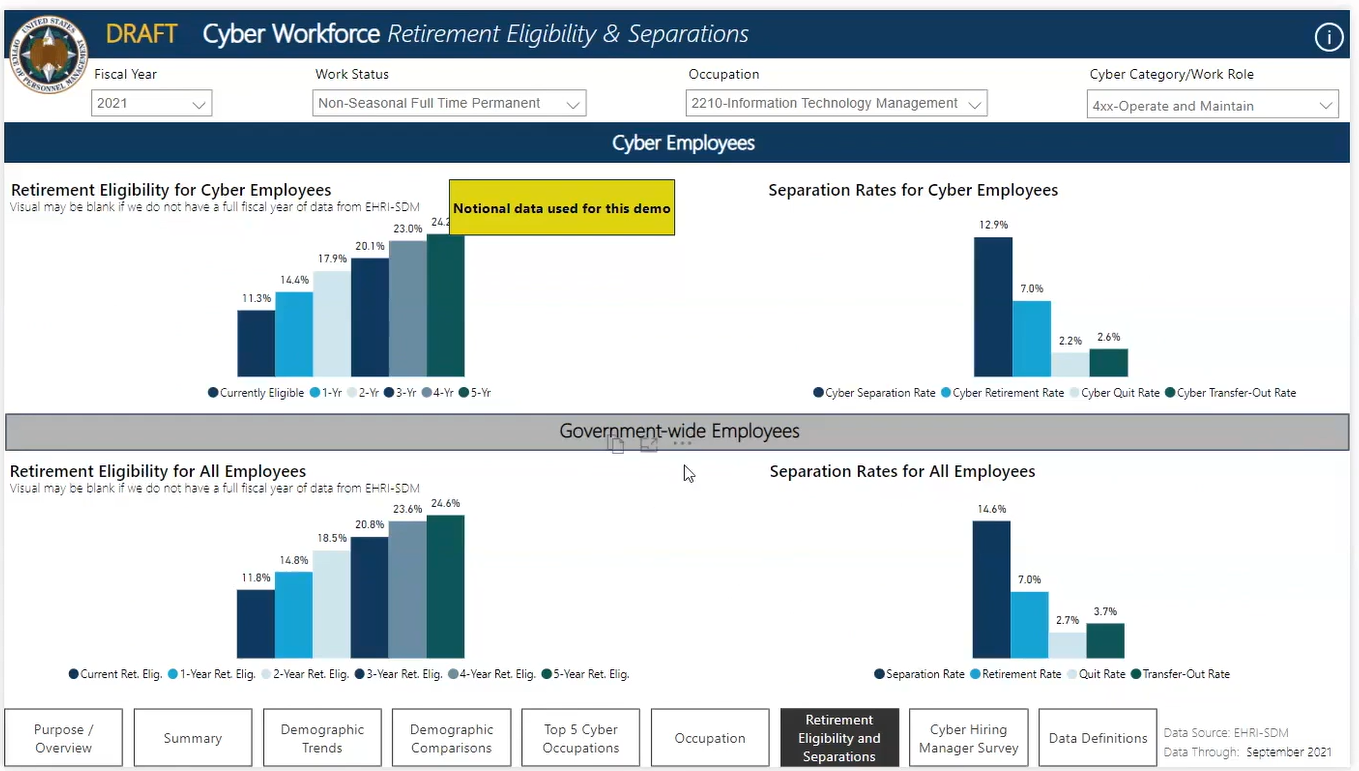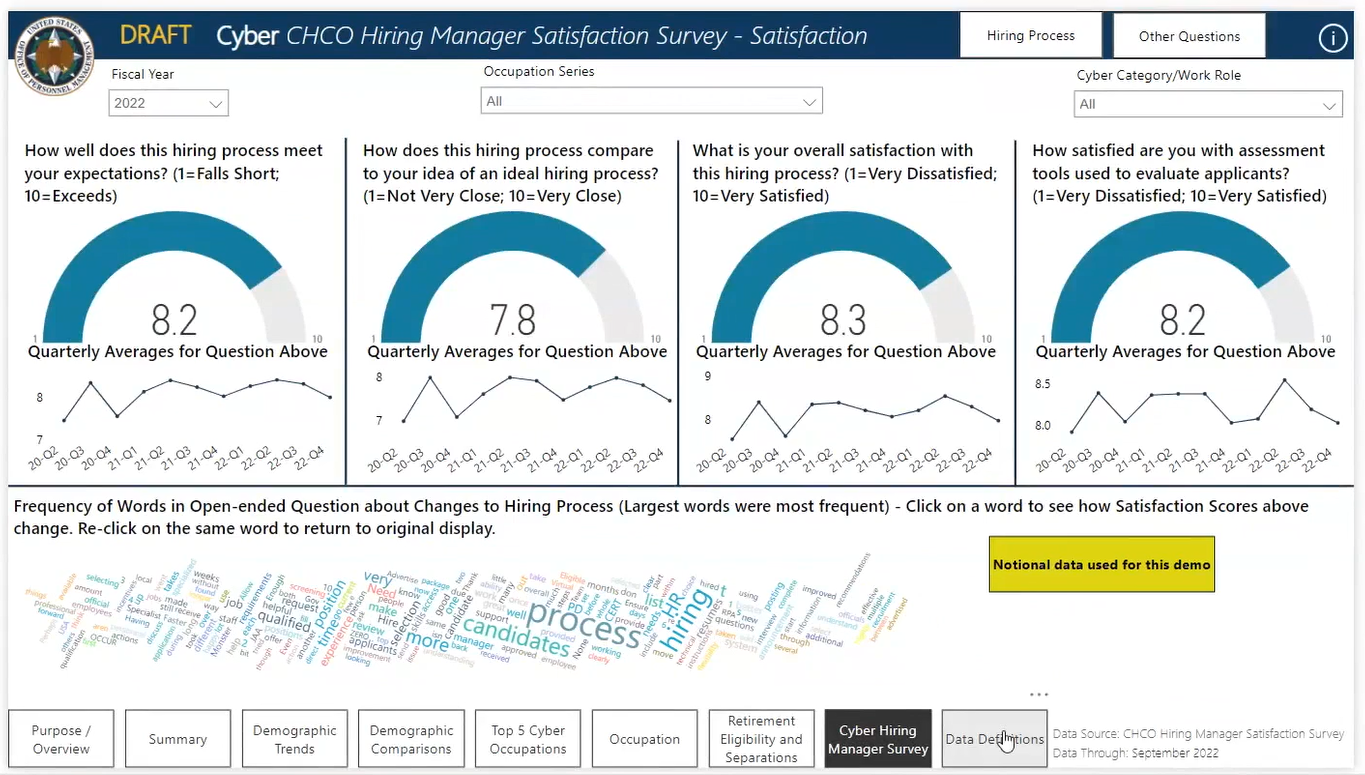
OPM putting final touches on cyber workforce dashboards
The Office of Personnel Management will soon launch a pair of cyber workforce dashboards to try to help agencies better understand gaps in their cyber workforce,...
The Office of Personnel Management is getting close to the finish line on another way to try to help agencies mitigate challenges in the federal cybersecurity workforce.
OPM will soon launch a pair of cyber workforce dashboards, aiming to give agencies more details on gaps in their cyber workforce, while also trying to attract more job candidates to open cyber positions.
“OPM has been working with the cyber community to better understand the data needs and has developed dashboards to support their workforce efforts,” OPM Deputy Associate Director for Strategic Workforce Planning Jason Barke said in an email to Federal News Network.
The OPM initiative involves two distinct dashboards. The first will be public-facing to help job seekers find open cyber roles across agencies. The second dashboard, which Barke said will be more “granular,” is intended for internal agency use and will include data, for instance, on time to hire and attrition rates.
“The dashboards will allow agencies to better understand who is being hired, who is leaving, retirement eligibility, demographic status and other key information needed for workforce planning,” Barke said.
Using fake data, OPM recently offered a preview of the dashboards to show agencies how they can sort through and look at information on their cyber workforce.
With the dashboard, agencies will be able to filter down data on different cyber work roles. From a list of overarching cyber sectors — such as “analyze,” “investigate” and “collect and operate” — agencies can then pick out specific roles within each of those categories. From there, agencies will be able to see trends in areas such as retirement eligibility and separation rates for the positions they select.

“They can really go in and drill down deep and do some benchmarking and some comparisons to understand if their workforce looks like other workforces, and what those important trends are,” Barke said during a March 29 Nextgov event. “Are we hiring in an efficient and effective way? Are we losing quality applicants because they’re going somewhere else, because we could not hire in a timely way? How does that impact our cyber workforce? Where are we losing key skills?”
Agencies will also be able to track trends over time for both hiring manager and job candidate satisfaction during the hiring process.

Additionally, agencies will have access to other information for cyber staff, such as pay, age, telework eligibility and retention rate. The information can be filtered down by occupation, work status, work role and more. Based on what a user selects, the data dashboard will show information for those specific roles. For demographics, only gender, age and education will be included.

One of the early challenges in setting up the two dashboards was figuring out how many cyber employees there actually were across government.
“Before we led this effort, there was really no way of knowing exactly where cyber work was taking place in the federal government,” Barke said during the event. “This was a key aspect to the first step of really workforce planning and understanding how we get that top talent.”
The dashboards stemmed, in part, from 2015 legislation called the Federal Cybersecurity Workforce Assessment Act, which required agencies to code every federal occupation as either cyber or non-cyber, using the National Initiative for Cybersecurity Education (NICE) framework to define the work roles.
Through that requirement, OPM determined there are 52 types of NICE roles in government. Across all of those positions, agencies coded roughly 140,000 roles as cyber-related, data on all of which will be included in the dashboards.
“By understanding this, we’re able to conduct targeted recruitment for specific skills, rather than just a blanket approach and hoping that we get the skill that we need,” Barke said.
The data on the dashboards will come from OPM’s Enterprise Human Resources Integration (EHRI) database. Notably, the dashboards will not provide real-time data — there is a roughly five-month delay for current information to populate in the dashboard, said Sarah Brickner, an OPM program analyst involved in the creation of the dashboards.
“We can’t do real-time data because it’s just not available to us within the EHRI database,” Brickner said during a National Institute of Standards and Technology (NIST) event in January. “You can use [the dashboard] for your workforce planning needs. There will be a delay, but I think when you’re trying to do workforce planning, you’re doing it a lot of months in advance, so I think that it should be helpful in that regard.”
OPM initially planned to publish the dashboards in the second quarter of fiscal 2023, but Barke said the two dashboards will launch “hopefully within the next month or two.” Once the dashboards are approved, they will be released on a data portal on OPM’s website.
Barke said he hopes the dashboards will help agencies better understand long-term workforce trends, and why they might be losing applicants.
“We look forward to really understanding that data, understanding where those hiring gaps are, where those staffing gaps are, and then being able to implement strategies [and] plans to close those gaps, and to really dive in and conduct some root cause analysis to understand why we may not be able to fill gaps,” Barke said.
Eventually, OPM also plans to create a total workforce dashboard, covering the same data for all governmentwide occupations.
“The same data … [we have] for cyber, we have at OPM that data for the total federal government,” Brickner said during the NIST event. “There’s a team that is working on that at this time.”
The effort comes as the government is struggling to recruit and retain cyber talent. OPM said cybersecurity remains a governmentwide skills gap — meaning many agencies have a lack of either cyber staff or knowledge, or both. Currently, there are more than 45,000 open cyber positions in the public sector.
“One of the areas that we’ve been leading really over the last three years is working closely with agencies to understand the landscape of the cyber workforce, and how we can support agencies ensuring that they have the cyber talent they need,” Barke said.
More cyber workforce initiatives from OPM
In a separate effort, OPM plans to launch a federal rotational cyber workforce program this fall. Through the program, agencies will be able to temporarily rotate cyber employees to other agencies for six months to one year.
“We think this is going to be critical to continue to develop skills in our cyber workforce,” Barke said.
“It will allow employees from one federal agency to rotate to another federal agency, learning important skills not only for their own growth, but for new ways of doing things … then bringing that back to their home agency. We see this as very valuable to continue to build those skills and for agencies to collaborate and learn from each other.”
OPM also approved a new Special Salary Rate (SSR) for IT workers, but the timeline for the rollout, as well as which agencies and positions will adopt the SSR, are still unclear.
And OPM has partnered with the National Science Foundation and the Department of Homeland Security on the CyberCorps Scholarship for Service program.
“It allows us to offer scholarships in return for service to those students engaged in this kind of work in academia,” Barke said. “Then they come to the federal government to help support our efforts.”
OPM’s efforts for the cyber workforce also match up with recent guidance on the future of work for federal agencies. The guidance has five key strategies, the first of which is policy and resources.
In this area, Barke said agencies have access to cybercareers.gov and a cyber resource hub on OPM’s website. These resources are more efforts from OPM trying to bridge the gap between hiring managers and job applicants, while also promoting hybrid work opportunities.
Copyright © 2024 Federal News Network. All rights reserved. This website is not intended for users located within the European Economic Area.
Drew Friedman is a workforce, pay and benefits reporter for Federal News Network.
Follow @dfriedmanWFED
Related Stories





